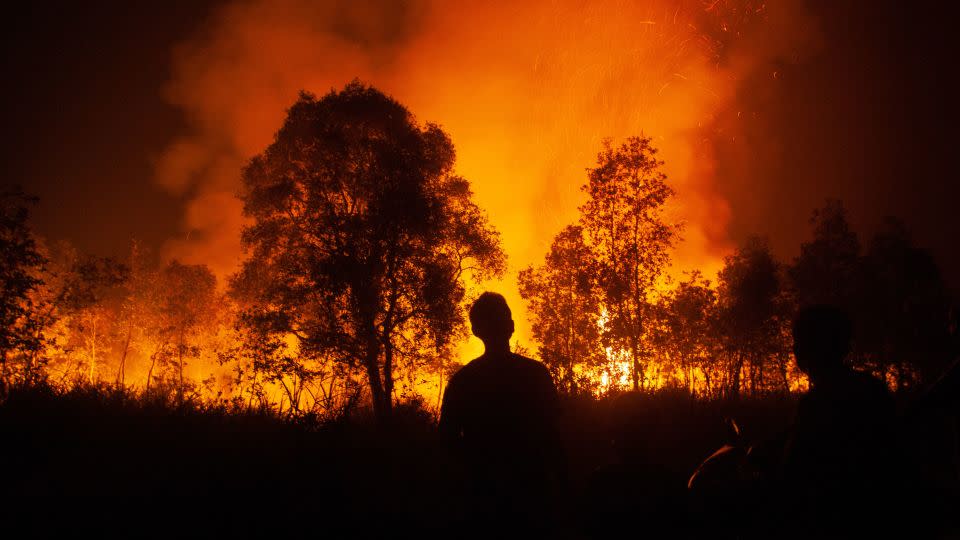Five graphics that show some of the biggest threats facing the natural world

Blazing fires, biblical floods and catastrophic storms are becoming increasingly common but they could be just a taste of things to come. Scientists say our planet is teetering towards a number of climate “tipping points” which could cause irreversible changes to the place we all call home.
From the Antarctic ice sheet to the Amazon rainforest, the consequences of climate change can be seen right now – but it’s not the only threat to the natural world. In a series of graphics, we take a look at some of the biggest environmental challenges facing our planet.
Dwindling biodiversity
Human activities including logging, pollution, overfishing and urban development are driving a staggering loss of biodiversity. Global wildlife populations plummeted by 69% on average between 1970 and 2018, according to WWF’s Living Planet Report 2022.
It notes that land-use change – which includes clearing land for agriculture or urban development – is the biggest current threat to nature, but adds that climate change is “likely to become the dominant cause of biodiversity loss in the coming decades.”
The UN’s landmark 2019 biodiversity report said that one million of all the planet’s eight million species are threatened with extinction. It reported that the global rate of extinction “is already tens to hundreds of times higher than it has been, on average, over the last 10 million years.”
Our fading forests
Trees soak up planet-heating carbon dioxide and forests can lock away carbon for centuries, but they’re disappearing at an alarming rate due to a combination of human activities.
Southeast Asia’s peat swamp forests are home to varied wildlife and hold large below-ground carbon stocks but many of these forests have been drained and degraded to make room for farmland. Drained peatland can dry up and turn into a tinderbox, and if it catches fire, it can release up to 10 times more carbon than forest fires.
Elsewhere, researchers have found that some tropical forests – including the southeastern part of the Amazon rainforest – are shifting from a carbon sink to a carbon source, adding more carbon into the atmosphere.
Problem plastic
It can take anywhere from 20 to 500 years for plastics to decompose and they can be found pretty much anywhere, from city streets to Antarctic sea ice and even drinking water. Not even the planet’s tallest peak or the world’s deepest ocean trench can escape plastic pollution.
The Great Pacific Garbage Patch, a 620,000-square-mile swirl of trash, floats on the ocean surface between California and Hawaii, threatening aquatic life with entanglement and chemical contamination.
Plastics pose a significant threat to wildlife from seals to seabirds, and have been found in the guts of many aquatic organisms, including every marine turtle species. Microplastics, plastics that have been broken down into tiny pieces, can be found in our drinking water systems and even floating in the air.
Pollinators on the brink
Pollinators include bumblebees, wasps, moths and butterflies, as well as birds and small mammals, like bats. But many are facing threats from pesticides and crop monocultures, as well as the destruction of their habitats.
A 2023 study from the University of Sheffield found that night-time moths account for a third of pollinator visits to crops, flowers and trees in all urban areas, but their global abundance has declined by 33% in the last 50 years.
If pollinators continue to decline in numbers, this could have serious repercussions for food production. One study estimated that the loss of pollinators globally is causing a decline in the supply of healthy foods that’s resulting in about 430,000 early deaths a year.
Bird populations under threat
Global bird populations face pressure from habitat destruction due to agriculture, development and logging, while seabirds are being impacted by overfishing.
In 50 years, nearly 3 billion birds have disappeared from North America’s skies and the UK has 73 million fewer birds than it had in 1970, according to research from the British Trust for Ornithology.
In Hawaii, 33 bird species have gone extinct since 1825 due to habitat loss and the introduction of mammals and disease, while in India, 178 species of wild bird are of high conservation priority.
Despite the scale of the challenges, there are countless groups and individuals committed to protecting our planet. For Call to Earth Day 2023, we’re celebrating the initiatives that strive to protect nature and our connected ecosystems across the world. Find out how you can get involved.
For more CNN news and newsletters create an account at CNN.com


